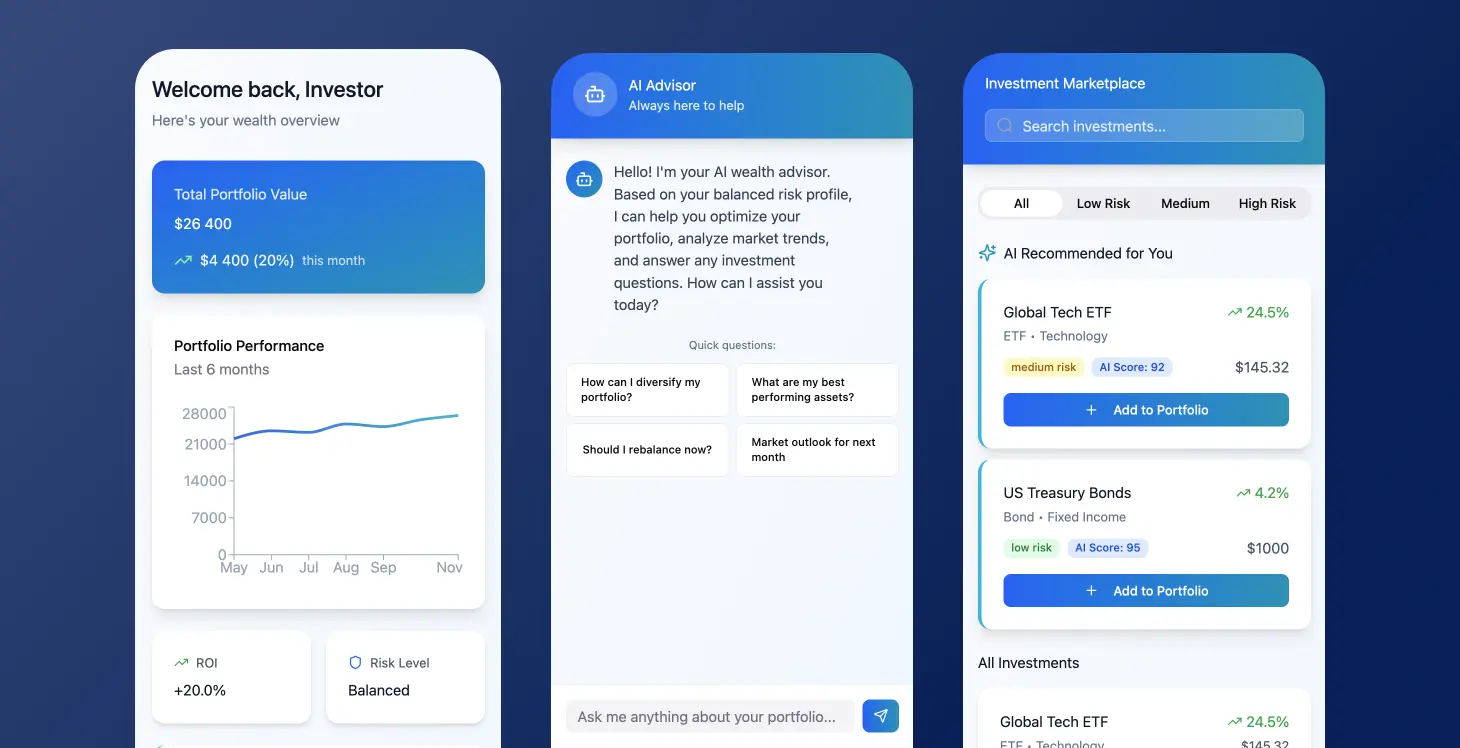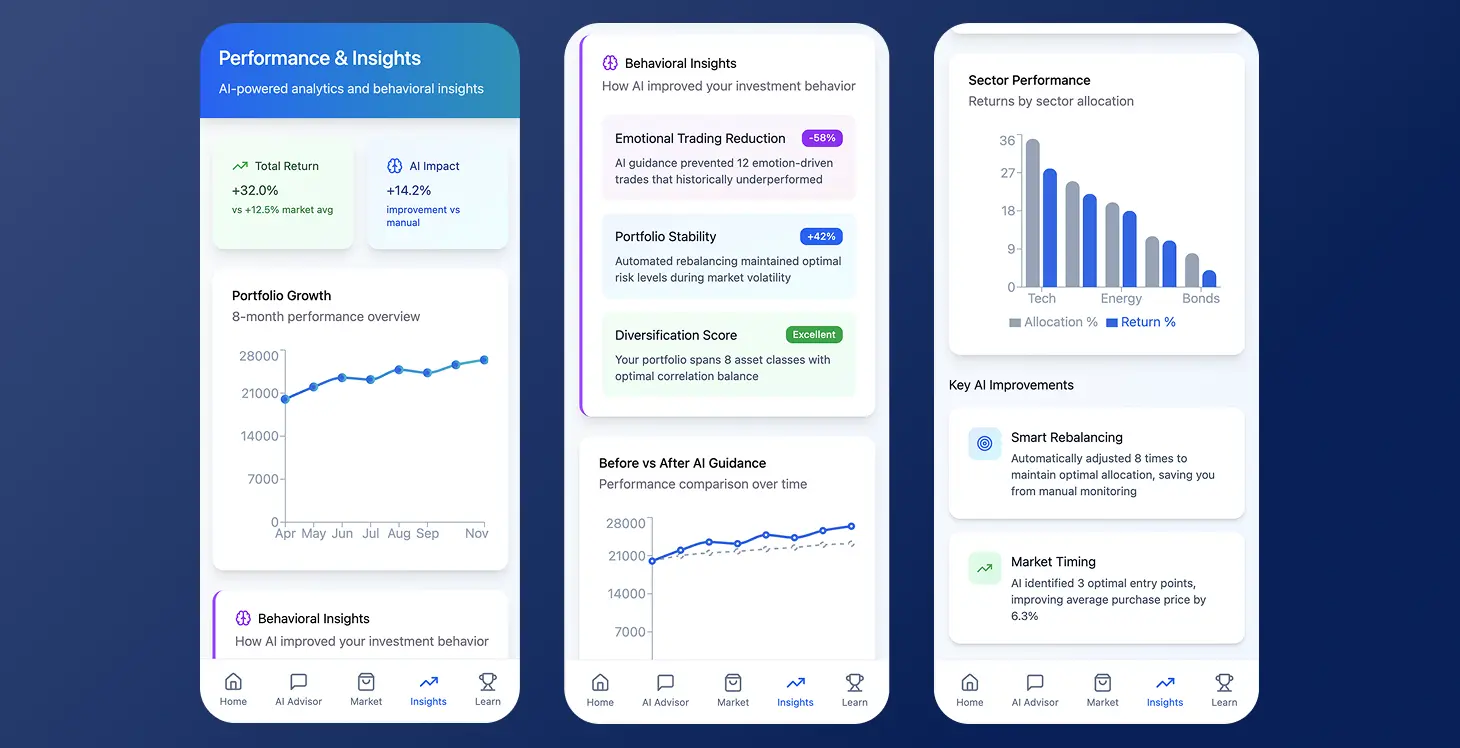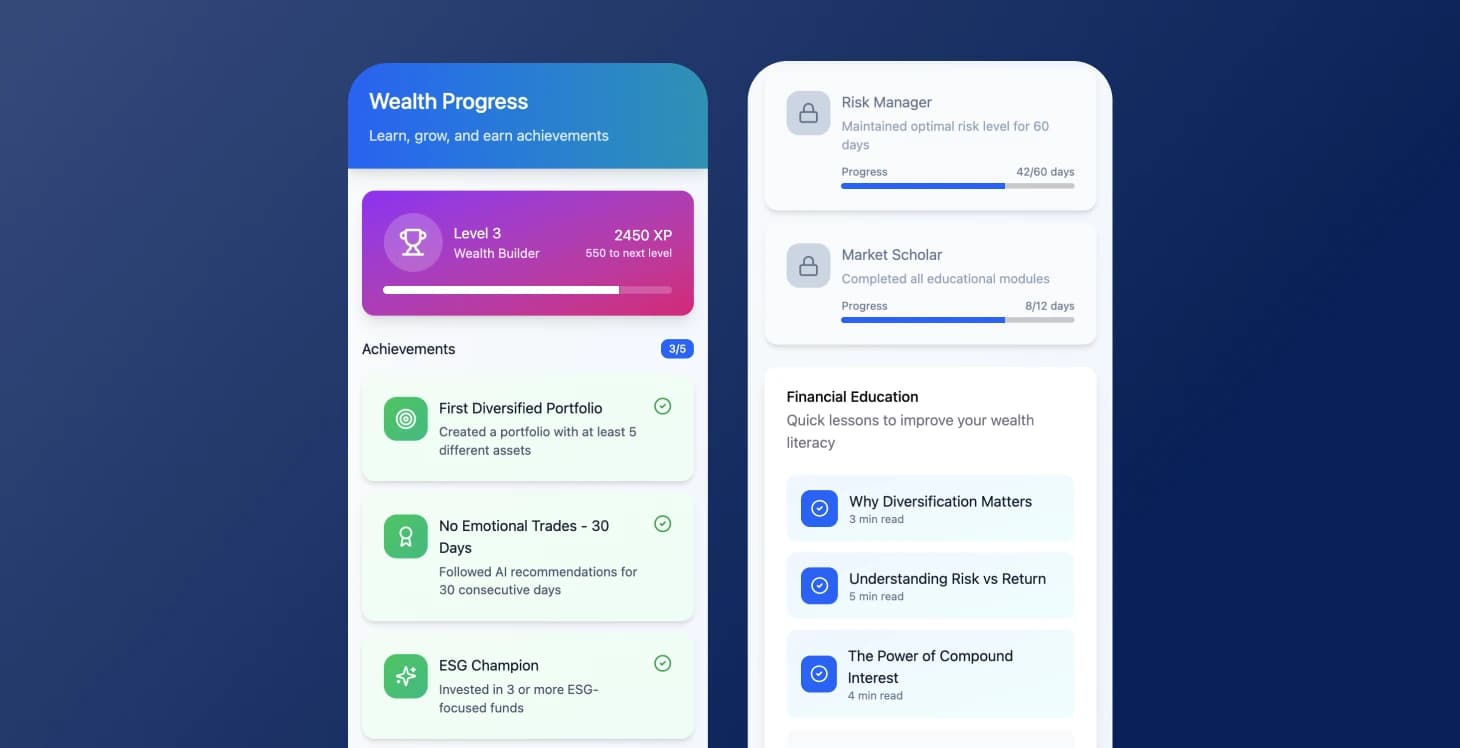


Project Overview
There is a movement towards making wealth management accessible to people through the use of advisory systems.
Traditional financial advisory services have historically posed obstacles for investors due to their fees and account minimums. Additionally these services often lack options for a number of clients.
Traditional Barriers in Financial Planning
The financial planning sector has traditionally functioned based on connections and personal interactions that have left out investors because of financial limitations.
Conventional advising companies ask for investments and impose annual fees of 1 to 2% making expert advice unattainable for those with limited assets. Regulatory standards introduce layers of intricacy concerning obligations like fiduciary duties and the need for transparent disclosures and compliance documentation.
Retail investors are now seeking self directed tools that offer insights like those used by institutions to make decisions in the markets ever changing landscape filled with various risks due to volatile conditions and complex financial options coupled with human biases influencing investment choices of novices in the field of finance.
The task at hand is to develop advanced analytical tools that comply with regulations and earn users trust on a large scale effortlessly.
Obstacles Faced by Retail Investors
Obstacles Faced by Retail Investors
Retail investors encounter obstacles when seeking quality financial guidance.
- Traditional financial advisors imposed fees of 1 to 2% along with account requirements exceeding $100K
- These barriers excluded around 80 percent of potential clients from their services
- Cost barriers incentivized prioritizing high value accounts over broader accessibility
Human advisors faced limitations in managing client portfolios due to scalability constraints leading to bottlenecks in personalization and responsiveness for clients needs. Manual effort was heavily required for market analysis and portfolio rebalancing tasks.
Institutional investors have access to research tools and real time analytics that individual investors do not typically have access to. Their decision making process often relies on delayed market data and simplified analysis methods.
Individual investors often made decisions based on emotions rather than logic when it came to their investments. They tended to trade without diversifying their portfolios enough or timing their moves effectively. This lack of guidance often resulted in poor investment outcomes due to cognitive biases affecting their choices.
The complexity of regulations such as investment advice compliance and fiduciary responsibility led firms to increase client fees to cover costs and disclosure standards.
Enhancement for Accessibility
The removal of investment prerequisites and a 67% decrease in expenses have broadened market access to demographics that were previously overlooked all while upholding service excellence.
Key Improvements
- Automated portfolio analysis and recommendation generation have allowed accommodation of over 50K users simultaneously without needing to hire additional staff
- Real time integration of market data and predictive analytics significantly decreased investment decision time from days to minutes resulting in a 23 percent enhancement in risk adjusted returns
- Compliance automation effectively lowered compliance costs by 45% thanks to integration of standards and audit trails ensuring adherence to fiduciary standards
Transform Your Investment Strategy Today
Experience institutional-grade tools with personalized guidance at fraction of traditional costs.
The implementation of risk mitigation strategies incorporating principles from behavioral finance and automated rebalancing techniques resulted in a noteworthy 58% decrease in emotional trading instances among the user community.
Market democratization has brought advanced tools to individual investors. This levels the playing field by granting access to advantages that were once limited to high-value clients.
Platform Architecture
The platforms structure focused on three core functions:
- Data intake and handling
- Analysis engines fueled by machine learning
- Compliant systems for delivering recommendations
Emphasis was placed on responsiveness, adhering to regulations and flexible personalization options.
Data Integration
We consolidated financial data sources like market updates and economic indicators with user portfolio details to create a comprehensive analytical system that allows for real time response to market shifts and trend analysis for predictive modeling purposes.
Machine Learning Implementation
Ensemble machine learning models fused quantitative measures with behavioral analysis and market sentiment assessment alongside risk evaluation algorithms for AI powered analytics deployment. The models iteratively absorbed insights from user engagements and market results to enhance the precision of recommendations.
Compliance-First Design
Incorporating regulatory standards into the system structure rather than treating compliance as an additional layer is the essence of compliance first design strategy implementation.
Automated audit trails coupled with standard enforcement and efficient disclosure management mechanisms guarantee consistent adherence to regulations without the need for manual intervention.
Personalization at Scale
Crafted personalized experiences on a large scale by creating user profiles that included:
- Risk preferences
- Investment goals
- Timeframes
- Behavioral trends
This approach offers tailored suggestions efficiently across diverse user groups.
Development and Deployment Strategy
Agile Development Approach
We followed an agile approach to development with weekly sprints that emphasized gradual feature updates and seamless integration of user feedback into the process. The multidisciplinary teams consisted of financial analysts, software engineers, compliance specialists and UX designers to guarantee a comprehensive approach to solution development.
Four-Tier Deployment Process
Deployment Environment Structure
| Environment | Purpose | Security Level | Data Type |
|---|---|---|---|
| Development | Feature Building | Standard | Synthetic Data |
| Testing | Quality Assurance | Enhanced | Anonymized Data |
| Staging | Pre-Production | Production-Level | Production Patterns |
| Production | Live System | Maximum | Real User Data |
Automated gates were implemented for promoting code to guarantee quality and compliance checks before deploying to production.
Testing and Validation
Implemented comprehensive automated testing process including:
- Unit tests for individual components
- Integration tests for API interactions
- Compliance validation at various checkpoints
This approach prevents violations in production systems through the CI/CD pipeline.
MLOps Infrastructure
Developed robust infrastructure for machine learning operations facilitating:
- Model versioning and performance monitoring
- A/B testing techniques
- Historical backtesting against established market conditions
This prevents overfitting to particular time frames or market scenarios.
Security and Risk Management
Implemented a comprehensive security strategy that includes:
- Encryption for data at rest and in transit
- Network segmentation and strict access controls
- Zero trust principles implementation
- Regular penetration tests and vulnerability assessments
This ensures resilience against changing threats in the security landscape.
Migration and User Adoption
We initiated our migration plan by rolling out features to beta user groups that reflect diverse demographics and portfolio sizes. This enabled monitoring of performance and gathering feedback before full deployment. Legacy system integration was maintained to assist users as they transitioned from traditional setups.
Results and Impact
The platform shift brought about significant enhancements in effectiveness, customer satisfaction and business growth measures.
Performance Metrics
- User engagement surpassed estimates with high retention rates
- Portfolio performance showed clear improvement compared to traditional approaches
- Operational statistics confirmed platform capacity to expand efficiently while adhering to regulatory standards
Lowering costs made market reach more expansive while upholding service excellence levels that were once exclusive to high-net-worth customers.
System Performance
- Security incident response averaged 1 hour 23 minutes meeting required standards
- Model retraining frequency optimized to 3 times per day
- System managed significant user increases without infrastructure scaling needs
- Peak concurrent user loads of 15K handled with no performance decline
Key Learnings and Best Practices
Compliance Integration
During implementation phase there were no instances of compliance or regulatory citations reported. Automated auditing features decreased compliance team workload by 45% while enhancing documentation quality and comprehensiveness.
User Trust and Transparency
Users value understanding the reasons behind AI recommendations as it boosts confidence in the advice given. By incorporating explainable AI elements:
- User acceptance rates increased by 34%
- Notable decline in support queries regarding recommendation logic
- Enhanced overall platform credibility
Data Quality Importance
The value of a system is deeply influenced by the quality of real time data it receives. Investment in premium data sources and validation processes proved crucial for maintaining system credibility and recommendation effectiveness.
Early Compliance Planning
Ensuring compliance from the start during project planning avoided expensive rework and feature limitations later in the process. Consulting regulatory experts early in development potentially cut development time by 6 months.
Behavioral Finance Integration
Integrating behavioral economics proved crucial for retail investor success. Purely quantitative models fell short in achieving optimal outcomes and preventing platform abandonment rates by users.
Continuous Model Monitoring
Continuous oversight is essential for monitoring shifts and biases in machine learning models as financial markets undergo transformations. Models relying on historical data may falter during regime changes or unusual market circumstances.
User Education Impact
User education plays a vital role in platform engagement. By incorporating educational materials and tailoring learning paths to individual preferences we observed:
- 67% boost in user engagement
- Substantial enhancements in investment decision quality
Infrastructure Scalability
During times of market volatility it's crucial to have infrastructure capacity to handle traffic increases from heightened financial market activities. This ensures users can access the platform without service disruptions during high stress market events requiring immediate attention.
Data Privacy Considerations
In financial services the utmost importance lies in safeguarding data privacy. User apprehensions regarding data security significantly influence adoption rates. Essential steps include:
- Establishing robust privacy protocols
- Frequent security evaluations
- Granting users authority to manage data sharing preferences
Technical Infrastructure
Core Technologies
Technology Stack Components
| Component | Technology | Purpose |
|---|---|---|
| API Gateway | Kong | Rate limiting and authentication |
| Data Streaming | Apache Kafka | Real-time data processing |
| Event Processing | Apache Storm | Stream processing |
| Primary Database | PostgreSQL | Transactional data |
| Time Series Data | InfluxDB | Market data storage |
| Graph Database | Neo4j | Relationship modeling |
| Caching Layer | Redis Cluster | Session and data caching |
| Container Orchestration | Kubernetes with Helm | Application deployment and scaling |
Monitoring and Security
- Monitoring Stack: Prometheus for metrics collection, Grafana for visualization, ELK stack for log analysis
- Security Framework: OAuth 2.0, JWT tokens, Vault for secrets management
- Infrastructure: Multi-region cloud deployment with automated failover capabilities
The transformation of wealth management through accessible technology platforms demonstrates how strategic implementation of AI, compliance automation, and user-centric design can democratize financial services while maintaining regulatory standards and operational excellence.
Project Results
- 67% reduction in service costs achieved
- 50K+ users served simultaneously
- 23% enhancement in risk-adjusted returns
- 45% decrease in compliance costs
- 58% reduction in emotional trading instances
Key Performance Metrics
Cost Reduction
Service cost decrease
User Capacity
Simultaneous users
Return Enhancement
Risk-adjusted returns
User Engagement
Engagement boost


